Mann, Kristen. "The Materiality of Abandonment in the Geometric Cyclades: Zagora on Andros." CHS Research Bulletin 11 (2023). https://nrs.harvard.edu/URN-3:HLNC.ESSAY:103377755
Early Career Material Culture Fellow in Hellenic Studies 2022-23
Few Geometric settlements are as well-preserved as Zagora on Andros (900-700 BC; Fig. 1). A densely inhabited, fortified, coastal town with substantial excavated assemblages, the site offers a rare opportunity to contextualize EIA Aegean socio-political developments at the household level. Undisturbed by later construction and carefully excavated,1 Zagora’s excellent preservation and relatively short – but still multi-generational – occupation span enable rigorous, high-resolution social analyses of daily, seasonal, and intergenerational lived experience.
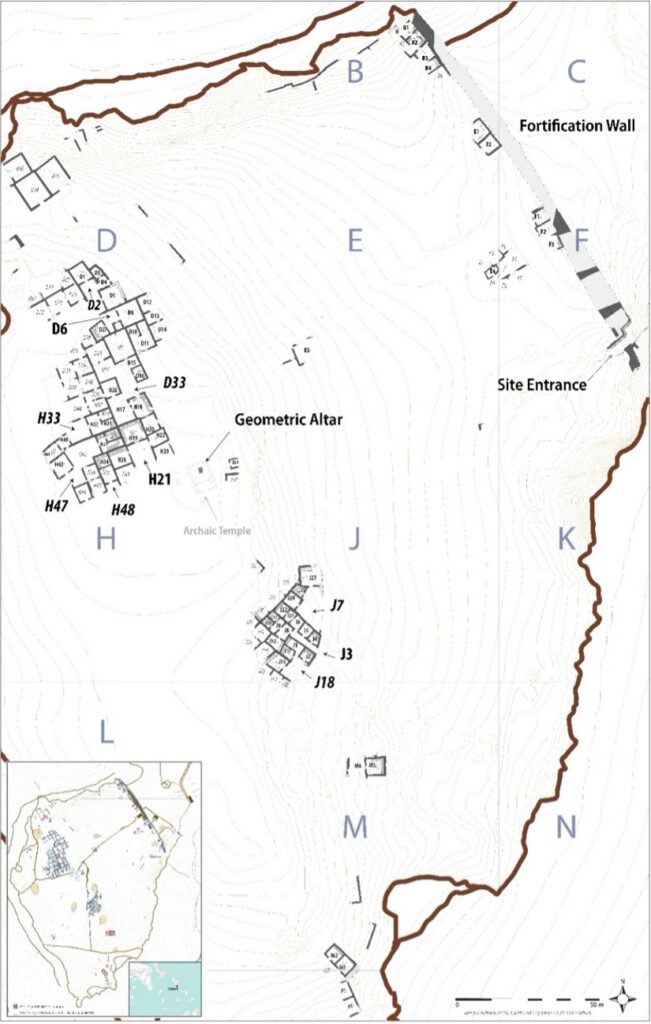
Zagora has become emblematic of 8th-century socio-economic change. Specifically, scholars have argued its layout evinces the rise of civic institutions, urban planning, evolving social structures, and nascent ideas of shielded gendered behaviour.3 However, the reconfiguration of domestic spaces at Zagora – and the site’s ensuing regular alignment – was driven more by internal developments, such as household lifecycles and changing needs, or spatial pressures caused by earlier growth and success (Mann 2019; In Press).
The 1967-1974 Australian team, led by the late Alexander Cambitoglou, were remarkably diligent: thanks to the vision of the field director, Judy Birmingham, they sieved all soils below topsoil, retained all finds (no matter material or preservation), took scientific samples and kept meticulous field notes. This data, largely unpublished, is perfect for querying household spatial behaviour. While close study of this material yielded numerous insights into seasonal lived experience and household dynamics, this report focuses on a suite of behaviours that came to loom large during this project: abandonment practices and choices. The mystery of why Zagora’s inhabitants packed up and left at the peak of its growth (c. 700 BC) has always tickled researchers, but substantive insights required deep material study embedded in contextual stratigraphic consideration of site formation processes. The results indicate that Zagora’s abandonment was not as simple as first thought, and profoundly shaped – perhaps even radically altered – the final ‘occupation’ assemblages as recovered on site.
Artefact distributions and abandonment behaviour across the site
A surprising amount of material was abandoned in the Zagora houses when they began to collapse, leading some to suggest a cataclysmic provocation for departure.4 While only nine ‘houses’ (here defined as a place of dwelling and locus of quotidian activities) have been excavated in their entirety (or near enough),5 all from the central plateau, we have a larger sample of 67 excavated rooms from across the site.6 Only material abandoned in situ is discussed here, as identified through a study of the context pottery from five houses (D33, H21, H33, H48, and J18) combined with the inventoried material from across the site.7 Inventory preservation extent (>33%) was used as a notional indication of stratigraphic context for assemblages not examined in person during this project, as such objects were likely in situ when the roof collapsed.8
Several rooms had over 20 in situ objects, though 7-9 was more usual.9 At first glance (Fig. 2) rooms in Area H appeared to have higher artefact counts than elsewhere, perhaps suggesting a difference in wealth or decisions regarding equipment discard. Yet patterns become clearer when abundantly discarded artefact types are filtered out (namely replaceable objects such as schist disks, spindle-whorls, stray lost beads, and common stone tools; see Fig. 3).
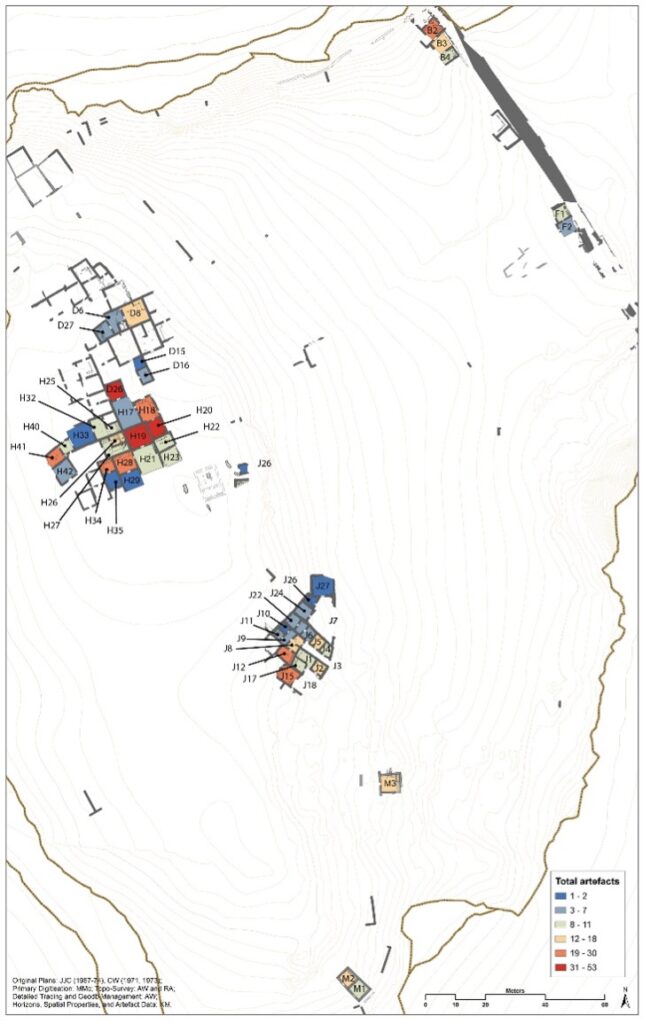
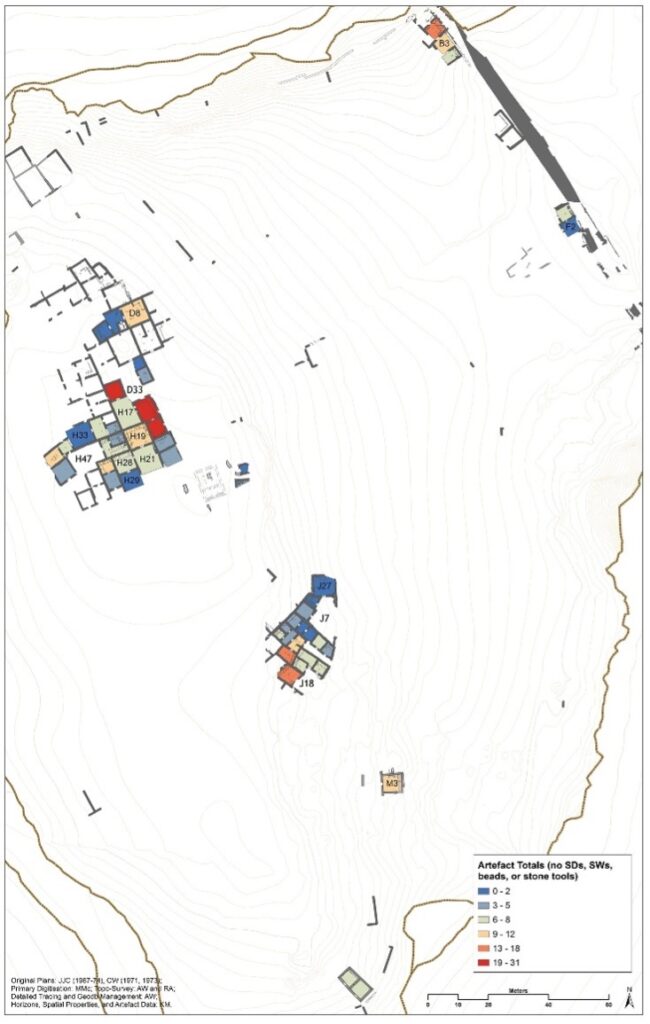
Rooms in Areas B and J (especially B2, J15, J12) had comparable counts to those on the central plateau (Fig. 3). Furthermore, most rooms with high counts (≥9) communicated with others with moderate or no artefacts.10 That is, most households confined belongings to select rooms. It is unclear if these patterns reflect original functional differences (e.g. did Rooms D8 and H19 always have more equipment than others in their houses?), or how households packed up when they left (e.g. moving equipment into one, perhaps lockable, room). The latter is likely given how neatly artefacts were stored, particularly along walls and near/on benches.11 This was clearly the case for the H48 House: its equipment was stashed in a rear storeroom (H34), and the entrance blocked with stones.12 However, the evidence varies: some rooms were stripped bare; others had skeleton assemblages; others contained many objects. Most houses contained substantial equipment.13 This evidence indicates a planned relocation of the inhabitants.14 The excavators believed that inhabitants left collectively or over a narrow timeframe, though there are hints that timing varied between houses.15 Either way, artefact findspots clearly reflect abandonment choices just as much as (probably more than) functional spatial use during permanent occupation.
The rooms that lack artefacts are striking, particularly deeper, darker, benched spaces that were likely storerooms (e.g. D27, H26, J10, J21, J26). Such spaces were unlikely void of portable, non-perishable equipment during habitation. Such rooms must have been stripped of contents during abandonment. This observation accords with the limited number of large storage vessels found throughout the site, valuable in and of themselves as well as for their contents.16 Though well represented in fragmentary material, only five neck-handled pithoi were found in situ, at least two of which were possibly in position before construction or renovation).17 McLoughlin convincingly argues such pithoi (whether decorated or undecorated) were commissioned for specific occasions from itinerant potters, likely for commodities of special significance (e.g. dowry gifts, or an excellent vintage).18 It is therefore unsurprising that few of these vessels were left behind, given the value of both the pithoi themselves and the commodities stored.19 The counts for in situ, more versatile,20 relief-band pithoi are slightly higher, but still less than 10 total, with a slightly lower count for plain and rope-band pithoi.21 Certainly far less than one would expect given household consumption requirements and Zagora’s copious storage benches with pot emplacements.22
While some rear storerooms contained high numbers of stored equipment of mixed utility (e.g. H34, B2), most rooms with high object counts were centrally placed, with good natural light, open/flexible floor areas, and often a central hearth (though not all such rooms contained substantial assemblages).23 The concentration of material in these core living spaces could suggest anticipation of a post-abandonment return, particularly if households did not require full use of the entire original house: that is, people returned for brief periods, requiring only essential equipment cached in select living rooms. This pattern could explain the tidy storage of equipment alongside why most hearths were neatly swept of ashes, as though ready for the next use.
There is no standard pattern to material abandoned in Aegean EIA houses. Some abandoned settlements contained very little, while others such as Vronda on Crete were more like Zagora, with many objects scattered throughout abandoned houses and no evidence of ‘rapid’ abandonment.24 It is, therefore, dangerous to presume what comprises a ‘normal’ abandoned assemblage, given the diversity of abandonment variables (such as the cause or speed of abandonment, distance between the new site and the old, modes of transportation, and whether the community left en masse, in stages, or anticipated the possibility of relocating back e.g. in case of venture failure).25 Yet, allowing for this, cooccurrence patterns in the Zagora houses suggest there was just enough equipment left to service basic needs (cooking, eating, drinking, limited storage) but not an entire household all year around.26 These patterns suggest deliberate intent behind what was taken and what was left, while variation between houses indicates that different considerations informed each household’s choice as to what to pack and what to leave.
Two further features are particularly striking: first, the dearth of loomweights (especially compared to the abundance of spindle-whorls: cf. Figs. 4-5); and second, the distribution of convivial equipment, particularly kraters (Figs 6-7).
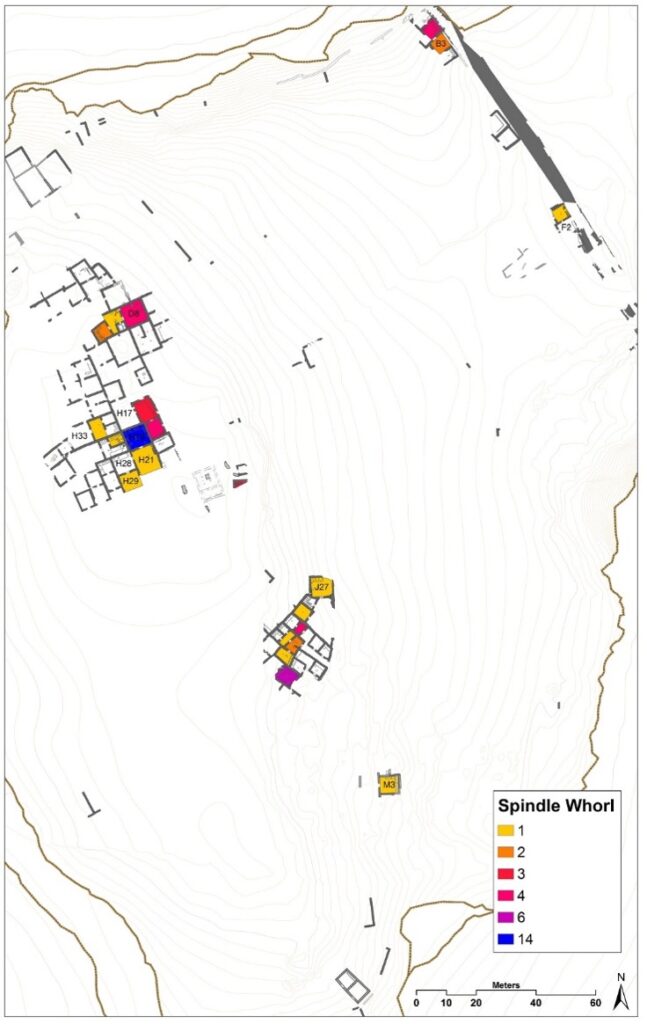
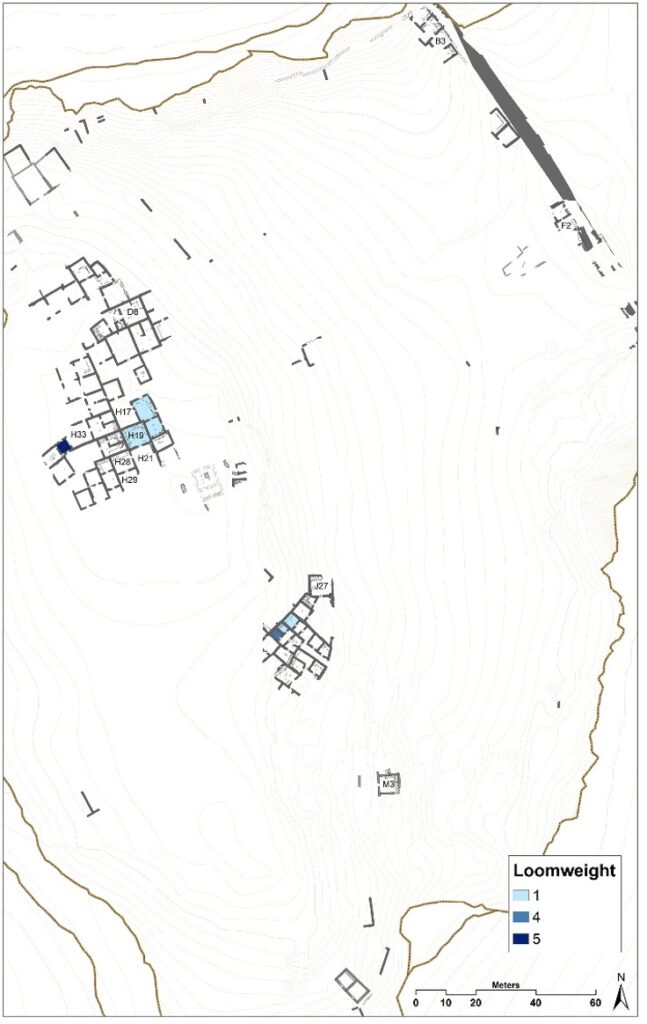
The prolific numbers of spindle-whorls scattered on final occupation floors (some clearly stored together, likely in baskets: e.g. in H19) makes sense: spinning wool was a critical, portable, but time-consuming activity. Perfect for keeping hands busy during rest or flexible tasks like waiting for food to cook. In contrast, loomweights were recovered as stray finds rather than complete sets: that is, each household chose to take their loom and matching loomweight sets with them. Given the value of looms and their importance to domestic production, this is unsurprising.27 However, it does confirm that households packed up with the intent of permanent relocation during the site’s abandonment, despite also choosing to leave behind select functional equipment.
In contrast, every fully excavated house (excluding those severely damaged by ploughing) contained at least one krater, together with decorated amphorae and a range of consumption vessels. If the inhabitants planned to return periodically for specific purposes (e.g. to celebrate an annual festival, or harvesting/tending lands), this pattern makes sense. Kraters were bulky and fragile to transport back and forth. The presence of several 7th-century cups in several houses appears to confirm that residents did indeed return after 700 BC, occasionally bringing back small portable objects with them to complement larger convivial equipment left on site.28
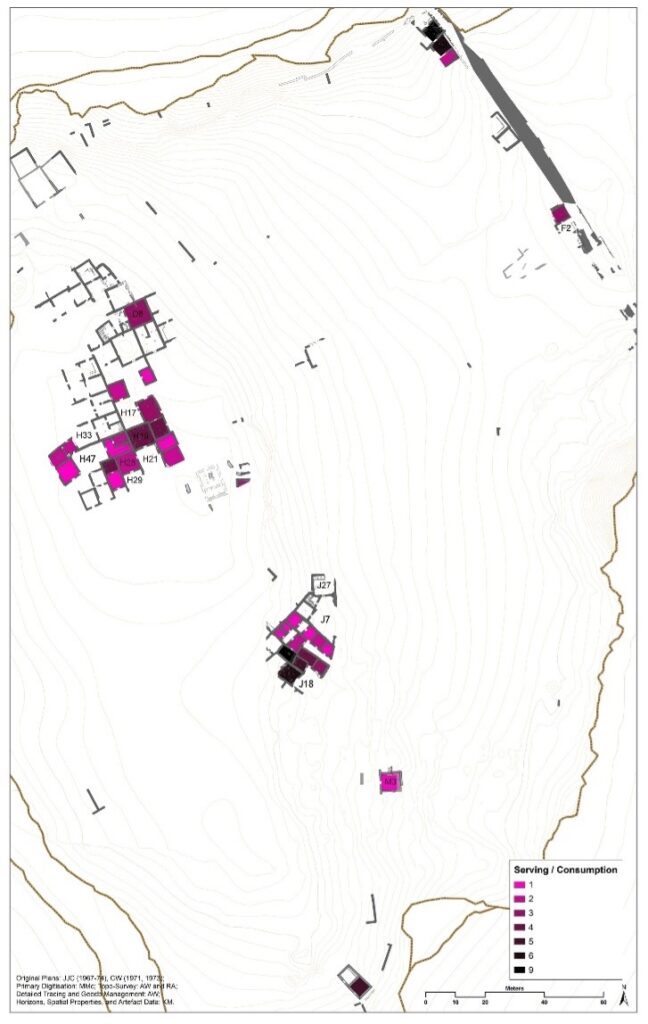
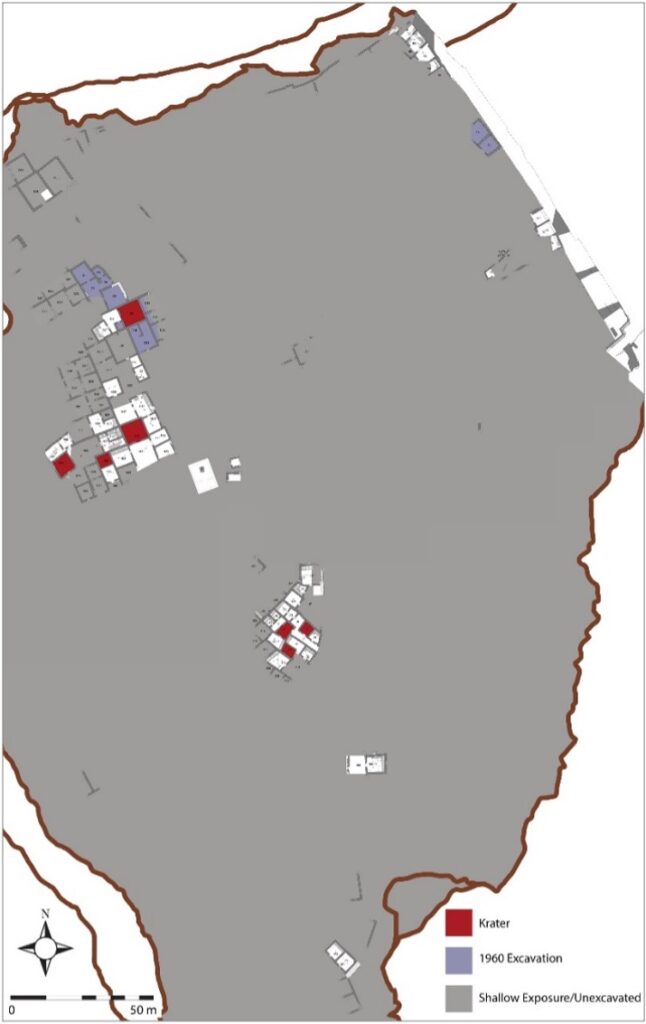
Leaving larger, more cumbersome vessels (at higher risk of breakage during transportation), behind against future need reflects a degree of pragmatism, particularly if people were travelling back to Zagora for short durations, either overland or by sea from their new homes (presumably at Archaic Palaiopolis further north on Andros, but potentially further afield). In this way, people could bring smaller equipment and consumable supplies that would serve over finite periods together with equipment left behind. Such practices could perhaps explain the lack of 7th-century material, which is one of the strongest arguments against any ongoing post-abandonment use of the houses before the construction of the Archaic temple: utilising abandoned equipment on return visits would result in a much lighter material footprint in terms of breakage and discard.
Archaic Zagora: Not truly ‘abandoned’, just no longer occupied
Possible ongoing use of the household structures (seasonally or sporadically) after the settlement ceased to be permanently occupied all year round was under-theorised in previous discussions of Zagora and its material corpus. We know that people returned to construct the temple in the 6th century. There is, however, a strong likelihood of continued ritual activity at the site prior to later investment in the temple’s construction (a construction project that also included enlarging the fortifications).30
Most abandoned domestic assemblages were adequate to meet the needs of periodic short-term needs, especially if complemented by more portable items carried to (and from?) the site. The quantity of material left behind, and the careful manner in which vessels were left stacked and ready (such as equipment by the hearth in J12), suggests semi-functional assemblages. Yet whether the anticipation of future visitation was fulfilled or not is another question. However, fulfilment of intent is suggested by: 1) later investment in the site (temple construction and fortification embellishment), indicating an enduring connection with the settlement or its hinterland; and 2) the tidy manner in which most rooms were left with their hearths swept out and their artefacts neatly stacked.31 Only new excavations driven by a targeted research program combining micro-data32 with relevant social and behavioural theoretical modelling can offer further clarity as to the nature of abandonment and post-abandonment behaviours at Zagora, and their significance for differential household behaviours and other socio-economic questions.
Regardless, the settlement’s growth and eventual abandonment should be seen as a natural escalation following its venture foundation in the late 10th century and exponential growth during the 9th and 8th centuries. The site testifies to the resilience and adaptivity of island communities who engaged with the outside world on their own terms.
Bibliography
Abbreviations:
Zagora 1 Cambitoglou et al. 1971
Zagora 2 Cambitoglou et al. 1988
Zagora 3 Paspalas et al. Forthcoming
Andros Museum Cambitoglou et al. 1981
Cited references:
Cabaniss, A.H.F., and Mann, K.P. 2016. “A Bayesian Framework for Combining Architectural Constraints and Artifact Assemblages in Domestic Spaces.” Paper presented at the conference The 81st Annual Meeting of the Society for American Archaeology, Orlando, Florida, April 6-10, 2016, Orlando, 2016, hosted by the Society for American Archaeology.
______ (in preparation). “The Aegean household in the Late Geometric–Archaic landscape.”
Cambitoglou, A. 1972. “‘Ανασχαφή Ζαγοράς ̉́Ανδρου (1971).” Praktika 126: 251-73.
Cambitoglou, A., Birchall, A., Coulton, J., and Green, J. 1988. Zagora 2: Excavation of a Geometric Town on the Island of Andros. Excavation Season 1969; Study Season 1969–1970. Athens: Athens Archaeological Society.
Cambitoglou, A., Coulton, J., Birmingham, J., and Green, J. 1971. Zagora 1: Excavation Season 1967; Study Season 1968–69. Sydney: Sydney University Press.
Cambitoglou, A., Peirce, S., Segal, O., and Papadopoulos, J. 1981. Archaeological Museum of Andros: Guide to the Finds From the Excavations of the Geometric Town at Zagora. Athens: Basil and Goulandris.
Cameron, C.M. 1991. “Structure abandonment in villages.” In Archaeological Method and Theory, edited by M. B. Schiffer, 155-94. Tucson: University of Arizona Press.
______ 1993. “Abandonment and archaeological interpretation.” In Abandonment of Settlements and Regions: Ethnoarchaeological and Archaeological Approaches, edited by C. M. Cameron and S. A. Tomka, 3-7. Cambridge: Cambridge University Press.
Cameron, C.M., and Tomka, S.A. (eds). 1993. Abandonment of Settlements and Regions: Ethnoarchaeological and Archaeological Approaches Cambridge Cambridge University Press.
Coldstream, J.N. 1984. The Formation of the Greek Polis. Aristotle and Archaeology. Opladen: Westdeutscher Verlag.
Coucouzeli, A. 2004. “From Tribe to State in the Greek Early Iron Age: The Archaeological Evidence from Lefkandi and Zagora.” In Το Αιγαίο στην Πρωιμή Εποχή του Σιδηρού, Proceedings of the International Symposium, Rhodos 1-4 November 2002, edited by N. C. Stampolidis and A. Giannikouri, 461–80. Athens: University of Crete/Archaeological Institute of Aegean Studies.
______ 2007. “From Megaron to Oikos at Zagora.” In Building Communities: House, Settlement and Society in the Aegean and Beyond. Proceedings of a Conference Held at Cardiff University 17-21 April, 2001, edited by R. Westgate, N. Fisher and J. Whitley, 169-81. London: British School at Athens.
Dawson, H. 2016. Mediterranean Voyages: the Archaeology of Island Colonisation and Abandonment. London/New York: Routledge.
Day, L.P. 2016. “The Pottery.” In Kavousi IIC: The Late Minoan IIIC Settlement at Vronda: Specialist Reports and Analyses, edited by L. P. Day, H. M. C. Dierckx, K. Flint-Hamilton, G. C. Gesell, K. T. Glowacki, N. L. Klein, D. S. Reese and L. M. Snyder, 47-116. Philadelphia: INSTAP Academic Press.
Day, L.P., Coulson, W.D.E., and Gesell, G.C. 1986. “Kavousi, 1983-1984: The Settlement at Vronda.” Hesperia 55 (4): 355-87.
Glowacki, K. 2002. “Digging houses at LM IIIC Vronda (Kavousi) Crete.” Pallas (58): 33-47.
Glowacki, K. 2007. “House, household and community at LM IIIC Vronda, Kavousi.” In Building Communities: House, Settlement and Society in the Aegean and Beyond. Proceedings of a Conference Held at Cardiff University 17-21 April, 2001, edited by R. Westgate, N. Fisher and J. Whitley, 129-39. London: British School at Athens.
Green, J. 1990. “Zagora – population increase and society in the later eighth century.” In Eymousia: Ceramic and Iconographic Studies in Honour of Alexander Cambitoglou, edited by J.-P. Descœudres, 41-46. Sydney: Meditarch.
Haggis, D.C. 1993. “Intensive survey, traditional settlement patterns and Dark Age Crete: the case of Early Iron Age Kavousi.” JMA 6 (2): 131-74.
______ 1996. “Archaeological survey at Kavousi, east Crete: preliminary report.” Hesperia 65 (4): 373-432.
______ 2015. “The Structuring of Urban Space in Archaic Crete: An Example of Settlement Development From the Early Iron Age to Archaic Periods.” Meditarch 25: 201-14.
Inomata, T., and Sheets, P. 2000. “Mesoamerican households viewed from rapidly abandoned sites: An introduction.” Mayab 13: 5-10.
Joyce, A., and Johannessen, S. 1993. “Abandonment and the production of archaeological variability at domestic sites.” In Abandonment of Settlements and Regions: Ethnoarchaeological and Archaeological Approaches, edited by C. M. Cameron and S. A. Tomka, 138-53. Cambridge: Cambridge University Press.
Kent, S. 1989. “The myth of ecological determinism: Anticipated mobility and site organisation of space.” In Farmers as Hunters: The Implications of Sedentism, edited by S. Kent, 96-133. Cambridge: Cambridge University Press.
______ 1993. “Models of abanfonment and material culture frequencies.” In Abandonment of Settlements and Regions: Ethnoarchaeological and Archaeological Approaches, edited by C. M. Cameron and S. A. Tomka, 54-73. Cambridge: Cambridge University Press.
Lang, F. 1996. Archaische Siedlungen in Griechenland. Struktur und Entwicklung. Berlin: Akademie Verlag.
Mann, K.P. 2014. “Social living: visualising spatial variability in households at Early Iron Age Zagora on Andros, Greece.” In Debating Spatial Archaeology. Proceedings of the International Workshop on Landscape and Spatial Analysis in Archaeology. Santander, June 8th – 9th, 2012, edited by A. García, J. García, A. Maximiano and J. Rios-Garaizar, 179-97. Santander: The Cantabria International Institute for Prehistoric Research.
______ 2015. “Mutable Spaces and Unseen Places: A Study of Access, Communication and Spatial Control in Households at Early Iron Age (EIA) Zagora on Andros.” Archaeological Review from Cambridge 30 (1): 52-62.
______ In Press-a. “Geometric Zagora on Andros.” In Routledge Handbook of the Archaeology of Classical Houses and Households edited by B. A. Ault and A. Sebastiani. New York: Routledge.
______ In Press-b. “Representation of the Individual in Household Archaeology ” In Proceedings of Work in Progress 2012. Interdisciplinary Conference for Graduate Students and Young Scholars, May 31 – June 2, 2012 at the Norwegian Institute at Athens (final revisions submitted 2014), edited by R. Storli. Athens.
Mazarakis Ainian, A. 2007. “Architecture and Social Structure in Early Iron Age Greece.” In Building Communities: House, Settlement and Society in the Aegean and Beyond. Proceedings of a Conference Held at Cardiff University 17-21 April, 2001, edited by R. Westgate, N. Fisher and J. Whitley, 157-68. London: British School at Athens.
McLoughlin, B. 2000. Searching for the Potter’s Intention: the Pithos Makers of Zagora. MA thesis, The University of Sydney.
______ 2011. “The Pithos Makers at Zagora: Ceramic Technology and Function in an Agricultural Settlement Context.” In The “Dark Ages” Revisited. Acts of an International Symposium in Memory of William D.E. Coulson, University of Thessaly, Volos, 14-17 June 2007, edited by A. Mazarakis Ainian, 869-84. Volos: University of Thessaly Press.
______ 2018. “Homeric Audiences: Potters, singers and harvest festivals in the eighth century BCE.” Paper presented at the conference Australasian Society for Classical Studies Annual Meeting and Conference 39, Brisbane, 30 Jan – 2 Feb, hosted by the Australasian Society for Classical Studies/The University of Queensland.
Mook, M.S. 2004. “Traditional architecture and archaeological reconstruction at Kavousi.” In Crete beyond the palaces: Proceedings of the Crete 2000 Conference, edited by L. P. Day, M. S. Mook and J. D. Muhly, 94-100. Philadelphia: INSTAP Academic Press.
Morris, I. 1999. “Archaeology and Gender Ideologies in Early Archaic Greece.” Transactions of the American Philological Association 129: 305-17.
Nevett, L.C. 2010. Domestic Space in Classical Antiquity. Cambridge University Press: Cambridge.
Papadopoulos, C. 2013. “An evaluation of human intervention in abandonment and postabandonment formation processes in a deserted Cretan village.” JMA 26 (1): 27-50.
Paspalas, S.A. 2017. “The Sanctuary at Zagora, Andros. Early Iron Age into Classical.” Paper presented at the conference Landscapes of Movement Religious Space and Topography of the Cyclades, 8th Century BCE to 8th Century CE, University of Saint Andrews.
Paspalas, S.A., McCallum, M., McLoughlin, B., Mann, K., and Wilson, A. Forthcoming. Zagora 3: The 1971 – 1974 Excavation and Study Seasons. Athens: Athens Archaeological Etaireria.
Schilardi, D. 2015. “Koukounaries of Paros and Zagora of Andros. Observations on the history of two contemporary communities.” In Zagora in Context: Settlements and Inter-Communal Links in the Geometric Period (900-700 BC). Meditarch Vol. 25 (2012): Proceedings of the conference held by The Australian Archaeological Institute at Athens and The Archaeological Society at Athens Athens, 20–22 May, 2012, edited by J.-P. Descœudres and S. A. Paspalas, 89-106. Sydney: Meditarch.
Stevenson, M.G. 1982. “Toward an understanding of site abandonment behavior: Evidence from historic mining camps in the southwest Yukon ” JAnthArch 1: 237-65.
Tomka, S.A., and Stevenson, M.G. 1993. “Understanding abandonment processes: summary and remaining concerns.” In Abandonment of Settlements and Regions: Ethnoarchaeological and Archaeological Approaches, edited by C. M. Cameron and S. A. Tomka, 191-95. Cambridge: Cambridge University Press.
Vink, M. 1997. “Urbanization in Late and Sub-Geometric Greece: Abstract Considerations and Concrete Case Studies of Eretria and Zagora c. 700 B.C.” In Urbanization in the Mediterranean in the 9th to 6th Centuries BC, edited by H. D. Andersen, H. W. Horsnæs, S. Houby-Nielsen and A. Rathje, 111-37. Copenhagen: Museum Tusculanum Press.
Westgate, R. 2015. “Space and Social Complexity in Greece from the Early Iron Age to the Classical Period.” Hesperia 84 (1): 47-95.
1 Andros Museum, 13, Fig. 4. Explored in 1960 by Zapheiropoulos, Cambitoglou’s team excavated Zagora from 1967-74 (Zagora 1, 5; Zagora 2, 13, 19). Excavation resumed in 2012 under the co-directorship of Paspalas, Miller, and Beaumont (Miller et al. 2013; Beaumont et al. 2014; Paspalas et al. 2015). All up, less than 10% of the site has been substantively excavated.
2 Mann In Press-a, Fig. 1. Original site plans and architectural drawings: Coulton (1967-74) and Williams (1971-73). Primary GIS digitisation of Coulton’s block plan: McCallum (2007-10). Topographic survey: Anderson, Wilson, and McCallum (2012-13).
3 Coldstream 1984, 18; Lang 1996; Vink 1997; Morris 1999; Coucouzeli 2004; 2007; Mazarakis Ainian 2007, 168; Nevett 2010, 37; Haggis 2015; Westgate 2015.
4 E.g. Schilardi 2015, 104; cf. Zagora 2, 241.
5 Zagora’s houses are notoriously difficult to define (Mann 2019, Appendix B1; Mann 2014; In Press-b). Rooms have been grouped together as a likely ‘house’ based on access and communication together with renovation histories as inferred from stratigraphic relationships between built structures. Spaces within a ‘house’ may be roofed or unroofed. Houses are referred to by their primary entry space (e.g. spaces H47-H42-H43-H26-H27 are the “H47 House”).
6 Mann In Press-a.
7 While Green expertly studied the artefacts in 1967-74, the volume of the corpus defied detailed study. For high-volume materials (ceramics, bone, shell and schist disks) only finds deemed chronologically, stylistically and/or typologically significant were inventoried and separated from the rest of the material (referred to as ‘context’ pottery or bone). Preservation completeness was not necessarily a criterion. Given this and advances in material knowledge (particularly coarseware), many whole artefacts still languish undocumented within the copious bags of pottery on Andros.
8 The houses subjected to fuller study so far bear up this supposition, with only the occasional small find or stone tool coming from earlier floor levels. Preservation is therefore a useful marker of presence (not absence) in lieu of full stratigraphic analysis.
9 Artefact counts ranged from 1 to 53 maximum, with a mode of 7, median of 8, and average of 11. Seventeen rooms had < 5 objects, another seventeen had 5-10, ten had 11-20 and eight had >20.
10 Other rooms with similar artefact counts (M3, B2 and B3) lack full spatial contextualisation, with adjacent areas unexcavated.
11 The careful placement of equipment was first observed by McLoughlin (pers. comm. 2008) and interrogated more fully as part of this research. On variable abandonment processes, see Cameron & Tomka 1993. For a simplistic dichotomy of rapid versus gradual abandonment, see Inomata & Sheets 2000, 6-7; cf. Tomka & Stevenson 1993, 192; Papadopoulos 2013, 32.
12 Green 1990, 44; Mann 2019, 223; Zagora 3, forthcoming. For plans: Cambitoglou 1972, Fig. 9; Zagora 2, Pl. 9 Plan IX.
13 For instance, B2 with its impressive assemblage (which includes large numbers of diverse non-local ceramics) and storage installations was likely the rearmost storeroom of its house. The only house with a dearth of material (J7) was severely damaged by ploughing: here, absence cannot reliably be inferred as meaningful.
14 Zagora 2, 241.
15 Ibid; McLoughlin 2000, 108. E.g. H34 may have been blocked while other buildings were still in use (Green 1990, 44; cf. Haggis 1993, 138-39).
16 McLoughlin 2000, 52, 89 (cat. #C2 and #C6); Mann, 2019, 244, 260-67.
17 See McLoughlin 2000, 52-61, 99-153, esp. 107-8 regarding findspots and preservation; Mann 2019, 261. One from H26, in the corner emplacement. This pithos was wider than the entrance. One in H32 and two in D26 (excavated 2013-14), likely set on or in the floor. One (M134 / McL. Cat. D12) dug in 1960 from Trench Γ, room 1. The last (Inv. M162 / McL. Cat. D10; excavated 1960) potentially came from an Area D house, most of which were substantially renovated during the final settlement occupation phase.
18 McLoughlin 2018; also briefly in 2011, 919-20; cf. McLoughlin 2000, 90-92,154-55. These pithoi were previously discussed as “applied-relief” or the “Tenos-Boeotian applied-relief pithoi”, but McLoughlin’s forthcoming research cogently overhauls this typology which was based only on decorated examples (McLoughlin, pers. comm. 2023).
19 McLoughlin 2000, 153-56; 2011, 916.
20 McLoughlin 2011.
21 Mcloughlin 2000; 2011; Mann 2019, App. D, figure D.15.
22 McLoughlin 2011, 916-18; see also McLoughlin 2000, 11-13, 82ff.
23 On room configuration, placement, and depth, see Mann 2015; In Press-a.
24 Day 2016; see also Day et al. 1986; Glowacki 2002; Glowacki 2007.
25 Stevenson 1982; Kent 1993. Also: Kent 1989; Cameron 1991; 1993; Joyce & Johannessen 1993; Tomka & Stevenson 1993; Papadopoulos 2013. See Dawson 2016 (esp. 258-59) for a nuanced study of abandonment variables in Mediterranean contexts, albeit as regards the abandonment (and colonisation) of whole islands rather than individual settlements. Cf. also Haggis (1993, 138; 1996, 379) and Mook (2004, 96) for a modern ethnographic example of later generations returning periodically to refurbished abandoned buildings. Particularly Haggis’s (1993, 142) observations that villagers returned temporarily for religious festivals, harvests, or alcohol production.
26 E.g. metals, particularly blades for which we have tangential evidence such as whetstones, but few in situ. Some differences are more subtle, like discrepancies between the range of shapes represented in fragmentary versus in situ material.
27 Cabaniss & Mann 2016; (in preparation). Cf. The Gortynian law implying looms were the inviolate property of the household (Inscriptiones Creticae IV 75)
28 Initial research presented in Paspalas 2017, with publication forthcoming.
29 I.e. krater absences in Areas B/E/F may be a factor of partial house excavation, while those of the J7 and H33 Houses likely represent the vagaries of post-depositional processes (both were affected by ploughing).
30 Paspalas (2017) is considering this issue regarding later sacred landscapes at the site. When cultic activity and pilgrimages to the site ceased is unclear, although we have no firm evidence of cultic material after c. 400 BC. We do have Hellenistic material sandwiched between roof collapse layers in Room M2: someone camped out there in that partially collapsed room.
31 To anyone who has a shared family holiday house or shack that is collectively self-maintained, such routines of leaving the lodging clean and tidy for the next guest are very familiar.
32 E.g. chemical and organic residues, phytoliths, and micro-stratigraphic analysis.
